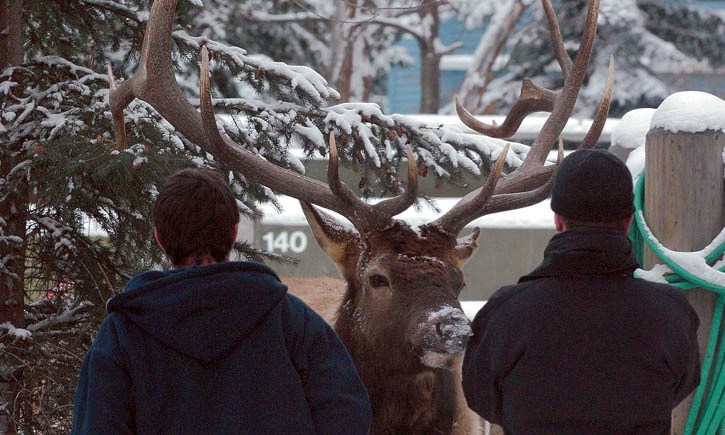BANFF – The distinctive sounds of the first bugles are echoing across the Bow Valley – and that can mean only one thing.
The fall elk rut has begun, which is a time of year when mature bull elk can be particularly dangerous and belligerent as they round up cow elk into harems in order to breed throughout September and October.
Parks Canada issued an advisory for Banff National Park on Aug. 29, which runs until Nov. 10 at the latest.
“We are in elk breeding season and the key message is to give them space,” said Cassandra Smyth, strategic communications advisor for Banff National Park.
“We do share this landscape with wildlife and it’s our responsibility to know how to recreate in the area with wildlife, especially during this sensitive time for the elk.”
In the fall mating season, bull elk bugle and rub trees, shrubs and the ground with their antlers to attract cows and intimidate other bulls.
When bulls display their antlers and body, they are gauging each other’s fitness and ability to defend the right to breed with the cows. Sometimes, bulls will wage violent battles with other bulls for a harem.
Everything about a bull’s display during the rut advertises his fitness to the cow elk and his toughness as an opponent.
Parks Canada and Bow Valley WildSmart have several tips for residents and visitors to stay safe during the rut, including keeping at least 30 metres away from elk.
“Picture this to be three bus lengths of space to put between yourself and the elk,” Smyth said.
Dangerous encounters happen most years as people get close to snap a photograph, but Bow Valley WildSmart program director Nick de Ruyter said people should not approach elk under any circumstances.
“Those male elk are very protective of the female elk, and anything other than female elk is a threat to them, whether it’s a car or truck, someone on a bike, or an off-leash dog,” he said.
“Definitely don’t approach to take photos or selfies.”
While bull elk may be aware of human presence, de Ruyter said it is important to still make lots of noise and carry bear spray at all times.
He said people should never attempt to sneak past elk, noting with school back in, now is a good time for parents to talk about elk safety with their kids who walk and bike to and from school.
“If elk are on a trail, turn around and find another way – or wait,” he said.
When elk gets too close, the advice is to act dominant by raising your arms or a jacket or umbrella to appear bigger.
Climb a tree or hide behind a large tree or a rock.
“If people don't have bear spray and they do get charged by an elk, try to position yourself behind a solid structure like a tree or a playground or picnic table, a porta-potty, a building or a car,” de Ruyter said.
“If you don’t have a buffer between you and the elk, you want to try and make yourself look big and loud and try to show your dominance,” he added.
“That can be tricky and scary so that’s why we say 'try not to get in those situations and carry bear spray, right’? That’s a lot easier to do than trying to make yourself look big and aggressive to a male elk.”
In addition, residents and visitors are advised to keep dogs on leash at all times.
Smyth said an unleashed dog may prompt elk to become aggressive as they view the dog as a predator.
“Elk can perceive your dog as a potential predator, like a wolf or coyote, and this may cause them to act aggressively towards your animal and towards you,” she said.
Smyth said Parks Canada’s wildlife team has responded to some calls about aggressive elk behaviour.
“However, there are no incidents of note, but we are getting reports of increasing amounts of elk being more aggressive towards tourists so it is the season,” she said.
Because elk and deer rub trees and shrubs with their antlers at this time of year, residents are being reminded to take down Christmas lights, ornaments, clotheslines and hammocks from their yards.
“We want to ensure that the elk don’t get entrapped, and unfortunately, getting entrapped can lead to great injury or loss of that animal,” Smyth said.
“We’re asking folks to do their part and help us keep our population healthy.”
Parks Canada asked that any incidents be reported to the resource conservation office at 403-762-1470.




